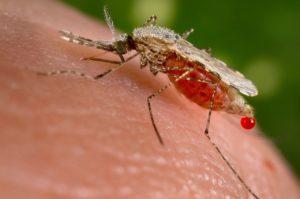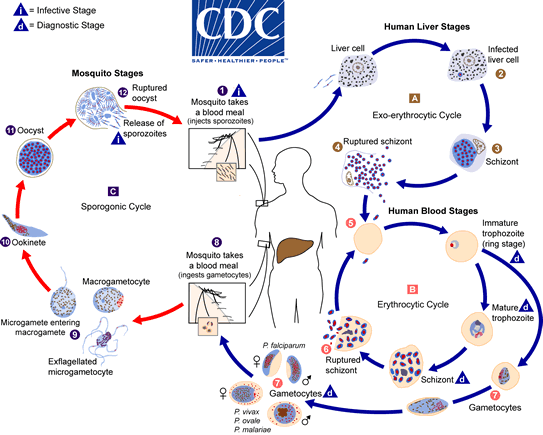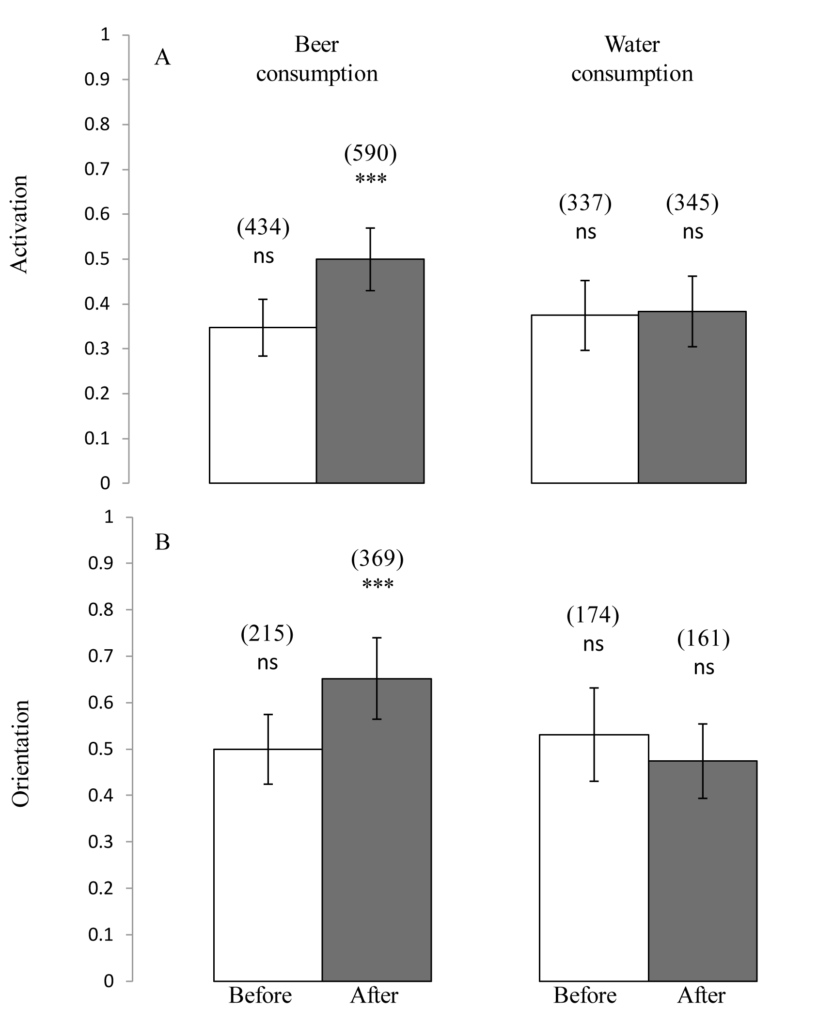
Beer as a Risk-Factor for Malaria
MALARIA
Malaria is one of the nastiest diseases known. It is caused by several different species of itty bitty protozoans from the genus Plasmodium.
The Malaria Disease Vector
A disease vector is medical-speak for the way a disease is transmitted between people. As you probably remember from high school biology, the vector for malaria protozoans are vampire bugs, otherwise known as mosquitos.
Malaria-carrying vampire bugs all belong to the genus Anopheles. By the way, the word anopheles comes from ancient Greek. It means useless. Go figure.

Malaria Symptoms
There are five different types of malaria that infect humans. Regardless, each malaria variant shares the same group of symptoms:
- chills
- fever
- sweats
- aches
- headache
- general malaise
Recurring Symptoms
The symptoms are similar to a bout of influenza and are often mistaken for it where malaria is uncommon. In comparison to the flu, the nasty bit is that malaria symptoms can recur in waves in a short period of time:
- Plamodium falciparum, Plasmodium vivax, or Plasmodium ovale cause the “tertian flu” variety of malaria. Symptoms can recur every other day.
- Plasmodium malariae cause the “quartan flu” variety of malaria. Symptoms can recur every third day.
Hidden Symptoms
In addition, there are other symptoms of malaria that are hidden. These include enlargement of both the liver and the spleen. Mild jaundice is also sometimes observed as well as nausea.
To make matters worse, the malaria protozoans Plasmodium vivax and Plasmodium ovale can go dormant in the liver. There they will reside for months – and sometimes years – until they revive and cause a relapse.
This is a brief description of the more mild forms of malaria, which are usually survivable and can often be cured. Please note that I said mild…
Severe Malaria
Though regular malaria is nasty, severe malaria is life threatening in comparison. Along with all the symptoms listed above, severe malaria can cause:
- rupture of the spleen
- kidney failure
- severe anemia
- hypoglycemia
- metabolic acidosis
- cardiovascular failure
- cerebral malaria, characterized by neurological abnormalities and strange behavior. It’s usually fatal.
Why Malaria is so Nasty
Trust me, what follows is the short form of how malaria operates. For the detailed version, I recommend the CDC website on this subject.
The Liver Stage
When a vampire bug bites you, she injects the malaria protozoans in the form of sporozoites into your bloodstream. What’s sporozoite? Well, think of it as a spore-like organism. It’s also a monster despite its size.
Those itty bitty sporozoites are parasites. They get into your liver cells where they are fruitful and multiply. They reproduce through schizogony.
Schizogony is straight out of B-grade horror movies. Each sporozoite starts to divide its cellular nucleus into many nucleii. It essentially cannibalizes itself while it turns into a womb-like sack containing many baby versions of itself. This morphed sack-like form is called a schizont.
The schizonts in the liver eventually explode, releasing many new daughter protozoans called merozoites. Merozoites are next life form stage of malaria.
The infection of the sporozoites and the explosion of the schizonts are the cause of the liver enlargement and jaundice associated with malaria.
The Blood Stage
The merozoites from the liver get into the blood stream. From there, they invade the insides of red blood cells. This is where the real damage from malaria starts to stack up.
- First, the merozoites turn into their own schizonts inside infected red blood cells.
- Next, the growth of the merozoite schizonts creates up waste products inside the red blood cells.
In a way, malaria parasites are like the eggs in the Alien movies who destroy their hosts from the inside-out. The growing schizonts and accumulating wastes burst the red blood cells. This cell destruction releases the waste products and the schizonts into the blood stream. These go on to cause blood-stage symptoms.
Blood State Symptoms
- The schizonts rupture and release more merozoites, which in turn infect more red blood cells. This further infection leads to more schizont growth, red blood cell destruction and even more re-infection. This cycle is behind the every-other-day or every-third-day repetition of malaria symptoms.
- Several of the waste products from schizont growth are toxins or other biochemical agents. These cause the body to react, resulting in flu-like symptoms of fever, chills, nausea, etc.
- The destruction of the red blood cells causes the malaria symptoms of blood-chemistry imbalance, spleen enlargement, anemia, hypoglycemia, and malaise.

Malaria Prefers the Tropics
Even the mild form of malaria is remarkable unpleasant. Fortunately, malaria is now rare in developed countries of the temperate zone like the United States or Argentina; however, malaria is still common less-developed countries, especially in the tropics, in places like southeast Asia and sub-Saharan Africa.
BEER
So what does beer have to do with malaria? It’s simple: drinking beer attracts the mosquitos that carry malaria.
No, this is no joke. It turns out that the vampire bugs of the genus Anopheles rather like people who have been drinking beer. What follows are descriptions of studies that support this.
The First Study
A study in Japan in 2002 used laboratory-raised mosquitos to test the attraction between vampire bugs and drinking beer. The researchers measured the number of mosquitos that landed on volunteers before and after drinking 350 milliliters (~12 oz) of beer. When they looked at their data, it turned out that the beer drinkers suffered more vampire bug landings after drinking their beer compared to the period before they drank their beer.
It was a clever study but it wasn’t perfect:
- The number of volunteers was small (12 people).
- The control group was even smaller (1 person). A control group of one is just not enough.
- the vampire bugs were not from the genus Anopheles, but rather from the genus Aedes.
Regardless, the study established that a species of mosquito was attracted to beer drinkers. Strangely enough, the study did not find a tie between mosquito landings with either skin temperature or ethanol in sweat. Therefore, the researchers concluded they had a correlation between beer and vampire bugs even though they could not determine why.
The Second Study
The second study was conducted by some French researchers who published in 2010. It was as sweet a study as you will ever see. It was brilliantly designed and ethically conducted. In addition, it used actual genus Anapheles mosquitos collected in the field in the sub-Saharan country of Burkino Faso. If you don’t recognize the name, it used to be known as the Republic of Upper Volta, a former French colony. Anyway, here’s how the study worked:
The Mosquitos
- The researchers collected pregnant Anopheles gambiae vampire bugs in Burkino Faso and raised their progeny for the study. By the way, the Anopheles gambiae mosquito is the primary vampire bug for carrying malaria in West Africa.
- They timed the study so that the Anopheles gambiae progeny were denied the opportunity to have a blood meal before the study started. In the unlikely event that one of the vampire bugs actually got to a test subject, there would be zero chance of infection.
The Study Volunteers
- There were 25 beer drinkers and a control group of 18 water drinkers used in the study, all men from Burkino Faso from a community approximately 30 miles from the vampire bug collection area.
- The study measured the response of the vampire bugs before and after the voluteers drank a liter of beer or water respectively.
The Study Design
- For each test run, batches of 50 vampire bugs were put into a “downwind box” that had a opening. The opening led into a duct through which air flowed into the box. In the upwind direction, the duct forked. One fork fed a draft of outside air towards the downwind box. The other fork that fed a draft of air that had blown past a test subject towards the downwind box. Traps were placed in the ducting to collect vampire bugs before they could reach any test subjects.

- The researchers measured two phenomenon. First, they counted how many vampire bugs left the downwind box to travel upwind, which they called activation. Second, they counted how many vampire bugs traveled down the fork in the ducting closest to a test subject, which they called orientation. Here’s the figure that shows their results:

As you can see, if we look at both the activation and orientation results, we can tell that vampire bugs prefer beer drinkers over water drinkers. The error bars are the 95% confidence limits. Looking at those error bars, it’s clear that the statistical significance for the before-and-after results is quite good for beer drinkers.
As a result, this may sound like a cliche, but it’s true
Clinical studies show that mosquitos who carry malaria really do prefer beer drinkers.
What interests me is the orientation data for water drinkers. Compared to beer drinkers, these results suggest that drinking water may actually discourage vampire bugs. Unfortunately, the problem here is that the error bars overlap too much, meaning that this result has no statistical confidence. The researchers therefore correctly stated that there was no real correlation. Regardless, this could be a starting point for a future study on whether water intake discourages mosquitoes.
The Third Study
The third study was not an experiment or clinical study. It was a statistical analysis of public-health data for migrant workers in Myanmar, the country that used to be called Burma. The study looked at personal habits like beer drinking. It also looked at the injuries and illnesses of the migrant workers. Researchers collected the data in 2011. After that, they analyzed the data and published their results this year, in 2017.
The results supported what the previous two studies concluded: that beer drinking leads to an increased risk of contracting malaria. Why? Because their results showed that workers who drank a lot of beer contracted malaria more often than workers who drank less or not at all.
WHY THESE STUDIES MATTER
The public health study is important. Why? Because it links the laboratory and field studies to a statistical analysis of public health data. This is significant because each of these studies used a different method but every one came to the same conclusion. Each study took a different road but they all arrived at the same place.
Yes, this would be funny if it weren’t a real result of scientific study. Beer drinking really does increase the risk of contracting malaria.
SOURCES
- https://www.britannica.com/science/malaria
- https://www.britannica.com/science/Plasmodium-protozoan-genus
- https://www.cdc.gov/malaria/index.html
- Shirai, O, et al. “Alcohol ingestion stimulates mosquito attraction.” J Am Mosq Control Assoc. 2002;18(2):91–96. https://www.ncbi.nlm.nih.gov/pubmed/12083361
- T. Lefevre et al. “Beer Consumption Increases Human Attractiveness to Malaria Mosquitoes.” PLOS One; 2010: http://journals.plos.org/plosone/article?id=10.1371/journal.pone.0009546
- Soe HZ, Thi A, and Aye NN. Socioeconomic and behavioural determinants of malaria among the migrants in gold mining, rubber and oil palm plantation areas in Myanmar. Infectious Diseases of Poverty. 2017;6:142. doi:10.1186/s40249-017-0355-6. https://www.ncbi.nlm.nih.gov/pmc/articles/PMC5674234/#CR23

4 thoughts on “Beer as a Risk-Factor for Malaria”
Considering that I don’t drink beer or any other alcoholic beverages, I should be save from those buggers. However jokes aside.
This is really interesting information. Do you know if maybe a research was made for people who drink sweet beverages oposed to beer/alcoholic beverages? ….. Maybe those blood suckers just really like the blood that has a higer sugar level…. OR maybe they just like to get drunk :p
That’s an interesting question. I would have to check the literature to see if sugary beverages have been tested. All sorts of things have been tested in the search for what attracts mosquitoes. It’s thought that it is odor that attracts them since mosquitoes do smell and ingested alcohol does turn into body odor. Strangely enough, animal-emitted CO2 is a mosquito attractant. Now alcohol on the breath has NOT correlated so it does look like body odor is the carrier.
I think beer has been targeted for research since in the countries where malaria is still prevalent, beer consumption trumps sugary beverages like soda. In a place like Ghana, 40% of the total sorghum crop (their #1 staple grain!) goes to making beer but you’re not going to find a soda vending machine outside of a big city airport. Beer is what a lot of people preferentially drink. Now I’m wondering if you could see an infection rate difference in mostly muslim countries where alcohol is banned.
The buggers don’t take after Alan. But they do me. We don’t drink beer. We eat the same. We both emit co2..so what is the real difference between us as far as the bugs can see I wonder.
Who knows? I suspect there’s some difference in what you eat vs. what Alan eats. Bugs are sensitive to what you eat – like garlic and fleas. Common wisdom has it that fleas don’t like people who eat garlic. I have no idea if there are any scientific studies on that. Maybe that’s fodder for a future blog post.
🙂